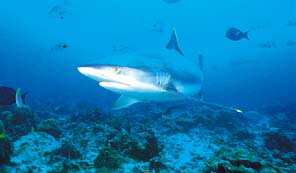CARCHARHINIDAE
Requiem Sharks
By Seishi Kimura
 Carcharhinus albimarginatus |
|
Small to large sharks; maximum size at least 7.4 m. Body cylindrical, not depressed without ridges on sides (weak lateral keels on caudal peduncle in some genera); precaudal tail (distance from posterior end of pelvic-fin base to origin of lower lobe of caudal fin) much shorter than head and trunk (distance from tip of snout to posterior end of pelvic-fin base). Head conical to depressed. Nostrils without barbels, nasoral grooves or circumnarial grooves. Mouth usually large, located well behind nostrils; teeth small to large, blade-like, with a single cusp and cusplets variably developed; anterior teeth in upper jaw smaller than lateral teeth and not separated from them by smaller teeth. Eyes located above mouth, with developed nictitating lower eyelids. Spiracles usually absent. Five small to medium sized gill slits, the last 1 to 3 behind pectoral- fin origin. Two dorsal fins without spines; the first larger than the second or almost equal-sized; first dorsal-fin base located above interspace between pectoral and pelvic fins; anal fin present, moderately large; caudal fin strongly asymmetrical, much less than a half of total length, with an undulated dorsal margin, a strong subterminal notch, and a well-defined lower lobe; precaudal pits well developed. Intestine with scroll valve, lacking spiral valve. Color: head and body gray, yellowish, or bluish dorsally, white or pale yellow ventrally, sometimes with prominent dark or light marking on fins. Similar families occurring in the area. Hemigaleidae: intestine with spiral valve; spiracle present but minute; upper teeth with strong distal cusplets. Proscylliidae and Triakidae: dorsal margin of caudal fin not undulated; precaudal pits present; intestine with spiral valve; spiracle present.Scyliorhinidae: first dorsal-fin origin just above or slightly anterior to pelvicfin origin. Ginglymostomatidae: first dorsal-fin origin posterior to pelvic-fin origin; nasoral grooves present; eyes posterior to mouth. Odontaspididae: eyes without nictitating folds; all gill slits anterior to pectoral-fin origin. Lamnidae: caudal fin lunate, almost symmetrical; eyes without nictitating eyelids. Remarks. Circumglobal in the tropic and temperate areas of Pacific, Atlantic, and Indian Oceans. Marine, occasionally in freshwater lakes or rivers. Typical predator, feed on almost all aquatic animals. The larger species are dangerous to people. |

|
|